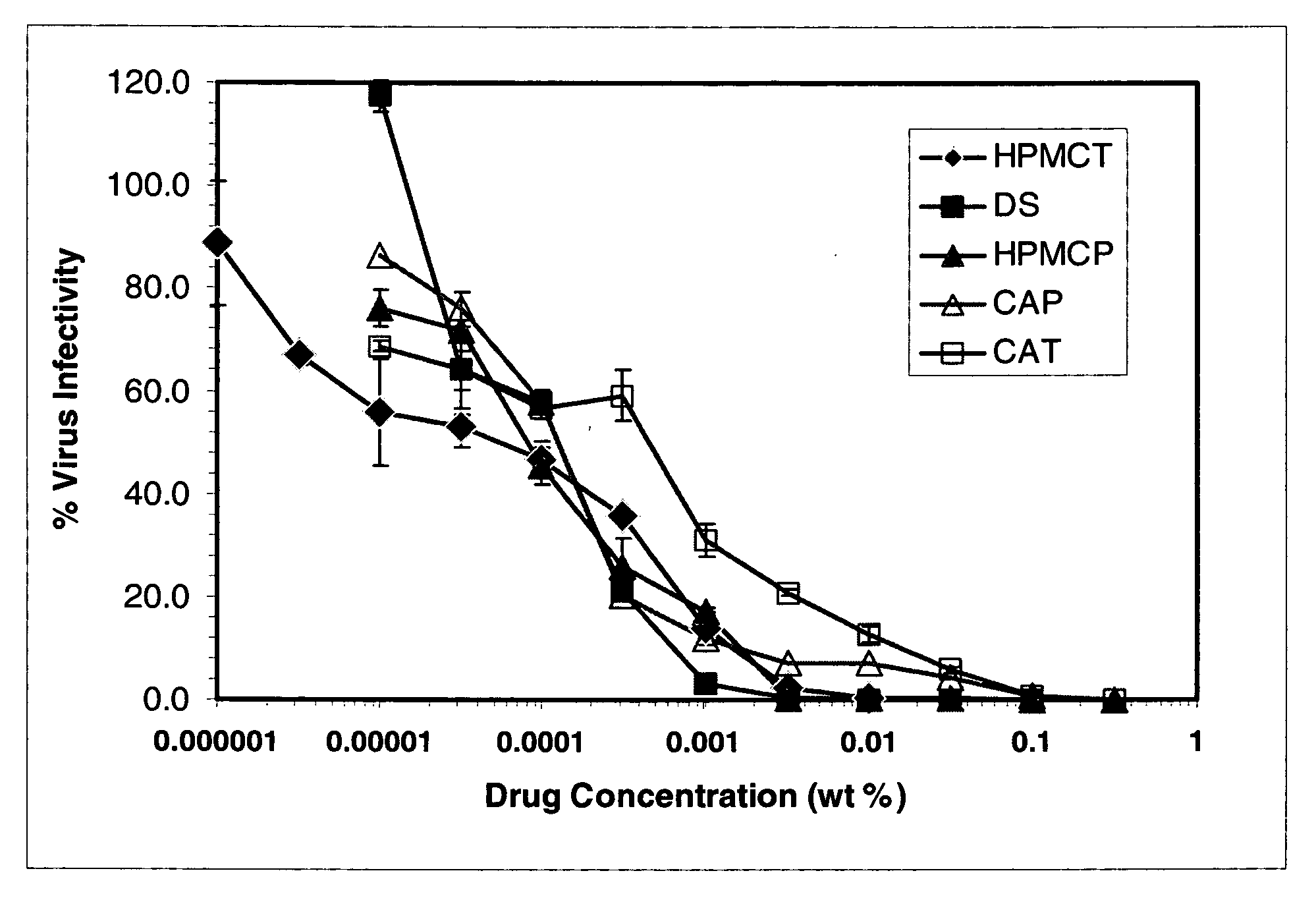Cellulose and acrylic based polymers and the use thereof for the treatment of infectious diseases
a technology of acrylic based polymers and cellulose, which is applied in the direction of synthetic polymer active ingredients, antibacterial agents, drug compositions, etc., can solve the problems of stds can also be transmitted, and stds adversely affecting the life of millions of people worldwide, etc., to achieve rapid emergence of antiviral resistance, poor oral bioavailability, and lack of inhibitory
- Summary
- Abstract
- Description
- Claims
- Application Information
AI Technical Summary
Problems solved by technology
Method used
Image
Examples
example 1
Synthesis of Acrylic Based Polymers, Copolymers or Oligomers.
[0257] Acrylic based polymers and copolymers are obtained using a variety of techniques that are apparent to one skilled in the art. For example, a synthetic scheme to synthesize MVE / MA involves the addition of 404.4 parts cyclohexane, and 269.6 parts ethyl acetate into a 1 liter pressure reactor. Next 0.3 parts of t-butylperoxypivilate are added at 58° C. in three installments of 0.1 part each at times 0, 60 and 120 minutes from the first addition. Seventy-five parts of molten maleic anhydride and 49.0 parts of methyl vinyl ether are mixed together and gradually added to the reaction vessel at 58° C. and 65 psi over a 2 hour period of time. The reaction mixture is then held at 58° C. for two hours after the last addition of initiator. (The presence of maleic anhydride is determined by testing with triphenyl phosphene to ascertain the extent of the completion of the reaction; the resulting complex precipitates out of sol...
example 2
Derivatization of Acrylic-Based Polymers, Copolymers or Oligomers to Achieve Enhanced Solubility at Low pH.
[0258] One skilled in the art could imagine several different mechanisms for creating diversity within the acrylic polymer or copolymer motif that will allow for variation in charge density or hydrophobicity. One mechanism is to interchange maleic anhydride in Example 1 above with any anhydride derivative of moieties containing one or more carboxylic acid group as shown in, but not limited to, Table 1. Alternatively a mixture of two or more anhydride containing moieties, derived from examples shown in Table 1, can be used to generate a polymer with alternating charged moieties. These moieties could be aliphatic or aromatic.
[0259] A second mechanism to modify the hydrophobicity or electrostatic charge of an acrylic based polymer is to replace methyl vinyl ether described in Example 1 above with styrene, methyl methacrylate phthalic acid, trimellitic acid, vinyl acetate, or N-...
example 3
Synthesis of Cellulose-Based Polymers and Copolymers or Oligomers.
[0261] For the synthesis of hydroxypropyl methylcellulose trimellitate (HPMCT), 700 grams of HMPC is dissolved in 2100 grams of acetic acid (reagent grade) in a 5 liter kneader at 70° C. Trimellitic anhydride (Wako Pure Chemical Industries) and 275 grams of sodium acetate (reagent grade) as a catalyst are added and the reaction is allowed to proceed at 85 to 90° C. for 5 hours. After the reactions, 1200 grams of purified water is poured into the reaction mixture, and the resultant mixture is poured into an excess amount of purified water to precipitate the polymer. The crude polymer is washed well with water and then dried to yield HPMCT. Hydroxypropyl methylcellulose acetate maleate (HPMC-AM) is synthesized similarly using a mixture of acetic and maleic anhydride in place of trimellitic anhydride. Other methods can be employed to generate the carboxylic acids substituted polymers of the present invention.
[0262] Th...
PUM
| Property | Measurement | Unit |
|---|---|---|
| pH | aaaaa | aaaaa |
| pKa | aaaaa | aaaaa |
| volume | aaaaa | aaaaa |
Abstract
Description
Claims
Application Information
 Login to View More
Login to View More - R&D
- Intellectual Property
- Life Sciences
- Materials
- Tech Scout
- Unparalleled Data Quality
- Higher Quality Content
- 60% Fewer Hallucinations
Browse by: Latest US Patents, China's latest patents, Technical Efficacy Thesaurus, Application Domain, Technology Topic, Popular Technical Reports.
© 2025 PatSnap. All rights reserved.Legal|Privacy policy|Modern Slavery Act Transparency Statement|Sitemap|About US| Contact US: help@patsnap.com



